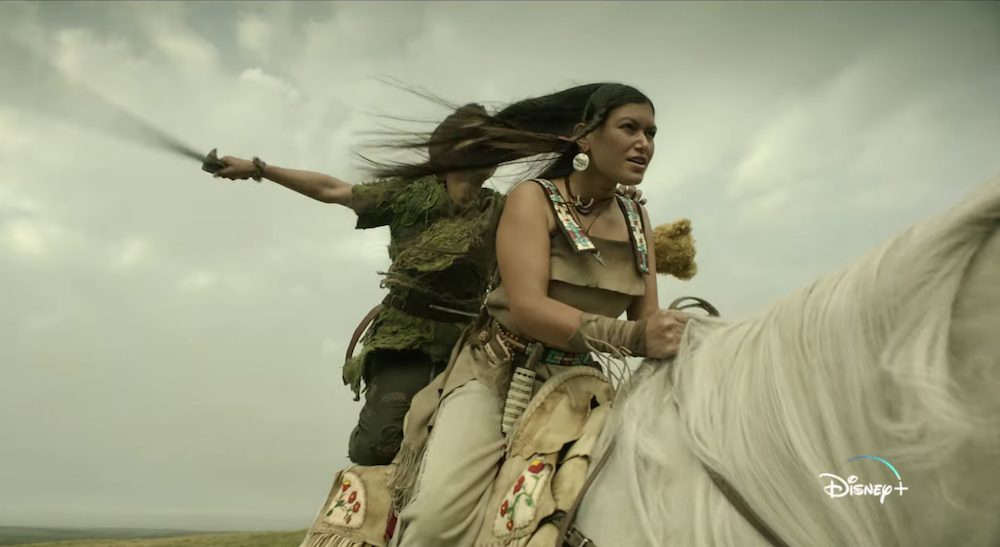
- Details
- By Levi Rickert
Walt Disney Pictures on Tuesday released a trailer for its new film Peter Pan & Wendy, featuring Alyssa Wapanatâhk (Bigstone Cree Nation).
In the new live-action update of the 1953 animated classic, Wapanatâhk plays Tiger Lily, a warrior princess of Neverland’s Indigenous tribe and the daughter of the tribe’s chief.
The filmmakers said they went to great lengths to ensure the authenticity and properly appropriate how the Indigenous tribe was depicted in Peter Pan & Wendy. They consulted with Dawn Jackson (Saginaw Chippewa) and Dr. Kevin Lewis (Ministikwan Lake Cree Nation) during the film’s development stage and continuing through principal photography and post-production.
Lewis is an alumni from University nuhelot’įne thaiyots’į nistameyimâkanak Blue Quills (UnBQ), where he worked in the social work and Cree and Dene language programs, as well as a sessional lecturer for the university. He consulted on proper usage of the Cree culture on clothing, hairstyles, tribal markings, props, and set designs to ensure intentionality and authenticity were infused in every creative choice, including quill work, Tiger Lily’s saddle, and canoes created by Cree artists and craftspeople.

Wapanatâhk’s Cree heritage provided inspiration for the character and her people in the film to ensure they are grounded in authenticity and specificity, the filmmakers said.
“The filmmakers were looking for somebody who was obviously authentic (and) who actually comes from Native lineage — somebody who's actually Indigenous,” Wapanatâhk told Native News Online during a video interview. “They wanted to correct things to make things right. When I saw that, that was like a really big point for me, I realized I wanted to be part of this. I want to help out and be that person to help correct this thing that's going on in the world.”
Wapanatâhk said the filmmakers were originally going to depict another tribe in the film, but as time went on, the movie’s director, David Lowery, began to ask her if she wanted to bring Cree history and culture into the film.
“Once I saw them bringing Cree culture into the film, I thought this is really everything for me. And it's gonna be everything for people to see this,” she said.
Having Dr. Lewis on set was helpful to the young actress, whose character speaks both English and a dialect of Cree in the film.
“He was there basically the whole time and he helped me with the Cree language because I don’t speak Cree fluently. I was also able to reach out to my grandmother and my adopted grandfather who helped me with the Cree language,” Wapanatâhk said.
Wapanatâhk says it was important for the Peter Pan & Wendy filmmakers to portray Indigenous culture appropriately. She says playing the role of Tiger Lily helped her understand who she is as a person.
“I'm so in a place where it's like so deep in my heart, where I hold this character, and this film was one of the biggest things that ever happened to me and that ever came into my life. The reason for that is because I think as you're in your healing journey, you go through a lot of trials, a lot of tribulations and this was something that kind of brought me out of that. That deep, the loneliness. It brought me right out of it, and I was in my element.
“And I noticed that that had a lot to do with my healing because I was able to find myself and even though I was playing a different character, I found out who I am, I found out that I have a voice that I matter. All of these things came together and it's like you when you're talking to that little girl, or that little boy inside of you, and you're holding their hand and you're going through it together. That's why it meant so much to me because I know that a lot of other youth are going to see this though and they're going to maybe have those same feelings,” Wapanatâhk said.
In addition to Wapanatâhk, the background actors seen in Tiger Lily’s village along with her stunt double were all played by Indigenous talent.
While the character was inspired by the Cree culture, Tiger Lily and the Neverland tribe are still intended to be the Indigenous people of Neverland, not an actual Cree community.
Her people’s indigeneity to Neverland is reflected in both Tiger Lily’s relationships on the island as well as the birch bark teepees in which they reside.
Peter Pan & Wendy will be released on Disney + on April 28, 2023.
More Stories Like This
Vision Maker Media Honors MacDonald Siblings With 2025 Frank Blythe AwardFirst Tribally Owned Gallery in Tulsa Debuts ‘Mvskokvlke: Road of Strength’
Zuni Youth Enrichment Project and Partners at Ho’n A:wan Productions Launch 8th Annual Delapna:we Project
Chickasaw Holiday Art Market Returns to Sulphur on Dec. 6
Center for Native Futures Hosts Third Mound Summit on Contemporary Native Arts
Help us defend tribal sovereignty.
At Native News Online, our mission is rooted in telling the stories that strengthen sovereignty and uplift Indigenous voices — not just at year’s end, but every single day.
Because of your generosity last year, we were able to keep our reporters on the ground in tribal communities, at national gatherings and in the halls of Congress — covering the issues that matter most to Indian Country: sovereignty, culture, education, health and economic opportunity.
That support sustained us through a tough year in 2025. Now, as we look to the year ahead, we need your help right now to ensure warrior journalism remains strong — reporting that defends tribal sovereignty, amplifies Native truth, and holds power accountable.
 The stakes couldn't be higher. Your support keeps Native voices heard, Native stories told and Native sovereignty defended.
The stakes couldn't be higher. Your support keeps Native voices heard, Native stories told and Native sovereignty defended.
Stand with Warrior Journalism today.
Levi Rickert (Potawatomi), Editor & Publisher

